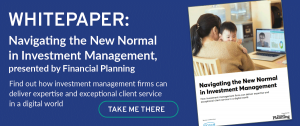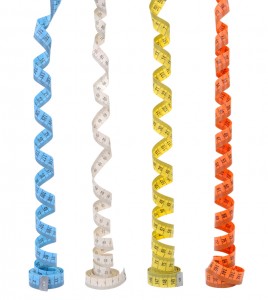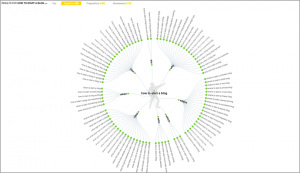Rita Kreig is the Inbound Marketer at Magoosh, an online test-prep startup in Berkeley, CA. She earned her Masters of Pacific International Affairs from UC San Diego, where she also studied nonprofit management. Rita loves all things education, marketing, and community development – be it creating and sharing new content or analyzing metrics. Follow Rita on Twitter and Google+.
They Came, They Saw, They Left
Having a blog post with a 90% bounce rate is like throwing a party where everyone walks in your front door, looks around, and then promptly leaves. Also known as … not good.

We all know that a certain degree of bounce rate is inevitable for any content, particularly when we are dealing with blog posts and blog landing pages.
When I promoted my first infographic, I remember being shocked by the above-average bounce rate on the content. It was beautiful, it had been user-tested with great results, and our promotions generated tons of views, feedback, and social shares.
What I didn’t realize at the time is that Google defines bounce rate as “the percentage of single-page sessions.”
Here is Google’s exact definition:
Meaning, the problem wasn’t necessarily with my infographic, but with the fact that my visitors came for the infographic, saw what they came for, and then left. They weren’t intrigued by, or interested in, the other content being offered.
My infographic wasn’t a failure! But the rest of my blog wasn’t doing a great job at sparking my audience’s interest.
Basically, they came to the party for the canaps and said, “I’m out” before the main course. It was a bummer, but also a valuable learning experience that taught me quite a bit about the relationship between interesting content and bounce rate.
Assumption Time
Before we discuss bounce rate problems and solutions in greater detail, we need to cover some basic assumptions. Let’s all start on the same page, so to speak.
Things we all know to be true:
- A high bounce rate is correlated with a decrease in page and site rankings. Google takes note of your bounce rate and decides that a high one means the quality of traffic to your site is low. Evidence shows that a high bounce rate can have harmful effects on your page and domain authority .
- “High bounce rate” means something different for different types of blogs and content. You have to know your site and your industry to determine which content is in the danger zone.
- Some bounce is okay, but you need to learn to minimize it to stave off adverse effects.
- Decreasing bounce rate can help improve your site’s conversion rate.
- Some types of high bounce rate are caused by technical issues on your site. We aren’t addressing those here.
Often, the reason your content has a high bounce rate is because:
- The user experience isn’t great.
- It’s not what your target audience wants, or it’s attracting the wrong audience.
- You forgot the content basics.
Time to elaborate.
It’s Like My Life Is Buffering: The User Experience Needs Improvement
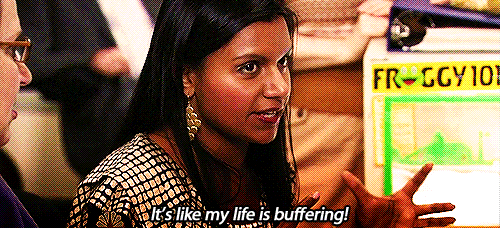 Like Kelly Kapoor from The Office, most people don’t like to be bored, confused, or bored and confused.
Like Kelly Kapoor from The Office, most people don’t like to be bored, confused, or bored and confused.
Often, the solution to your bounce rate issue lies with the user experience.
Ask yourself:
- Does your content have a bad layout?
- Is it disorganized, difficult to read, challenging to navigate, or lacking a simple search feature?
- Are readers bombarded by pop-ups, or asked to take long surveys?
- Is it only readable on desktop, and virtually impossible to access on mobile devices?
Maybe it’s just visually unappealing. The Internet is a very visual medium. So, if your content looks dated, blurry, or crowded, all but your die-hard fans will click away. And they’ll probably find alternative content that they’re happier spending their time with, even if it’s not as good as yours.
The messed up truth: If your content isn’t visually appealing and easy to use, people won’t know whether it’s good or not. Because they won’t stick around to find out.
Simple Solutions And Best Practices To Fix Your Content UX
- Switch to a simple, clean theme.
- Make that theme mobile responsive.
- Add an easy-to-find search box.
- Make navigation brainlessly easy.
- Stick with simple fonts and colors.
- Make headlines easily readable and scannable.
- Write in short sentences and short paragraphs.
- Use lists.
- Never forget the value of white space.
- Do everything in your power to make your content load quickly.
- One pop-up at a time. Avoid the center of the page, or save this for special occasions.
- Short, unobtrusive surveys.
- No annoying, unrelated animation. Ever.
2) It’s The User, Stupid!: Know Your Audience And What They Want
If James Carville were a marketer, I feel sure this is what he would say.
Two common pitfalls that lead to a high bounce rate:
- Pitfall 1: Your key audience is not interested in your content, or they’re not sure why they should be interested.
- Pitfall 2: Your content is not attracting your key audience.
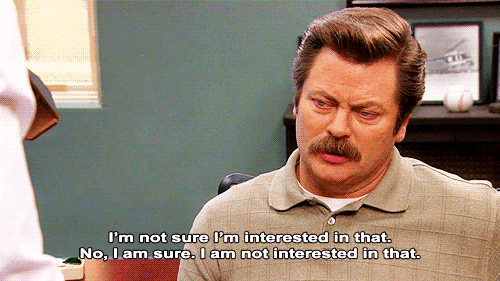
Image from Pinterest
I’ll start with Pitfall 1.
If your content isn’t hitting the mark with your target audience, then you’ve got your work cut out for you.
Either you need to know your audience better, or you need to sell your content better.
I had to learn to do both when I started running two blogs for high school students. Teens are a tough crowd, people. (Fun Fact: Teens are more likely to read your article if you include fun gifs! Now I can’t stop.)
Simple Solutions And Best Practices To Appeal To Your Target Audience
- Make sure your content meets a need and answers a common question.
- Segment your audience into user types, and create different landing pages for each.
- Base user types off of industry-specifics, geography, etc.
- Show different content to different user segments within your audience.
- At Magoosh, we write content for students, parents, and teachers. There’s a lot of information overlap, but the presentation and message changes.
- Make your content better. (Duh.)
- Include images, charts, graphs, quizzes, videos, and other visuals.
- Make your content interactive, and encourage conversation.
- Include one strong, appealing call to action.
- Include images, charts, graphs, quizzes, videos, and other visuals.
Now, let’s move on to the Pitfall 2.
What do you do if your content attracts views and users, but doesn’t attract your target audience?
If this is happening to you, your problem is that these users ingest this one page of appealing content and then bounce away, because they aren’t interested in your key offerings. They likely aren’t interested in your product, but reacted to a strong promotion or a clickable title.
Simple Solutions And Best Practices To Attract The Right Audience
- Rename content that has a lot of views, but a really high bounce rate.
- Perform keyword research to determine what your target audience is searching for, and use this information to write better headlines.
- Re-write posts with misleading titles.
- Maybe your post has an excellent title, but the content doesn’t fit. Make sure you’re taking full advantage of important keywords.
- Write good meta-descriptions for search engines. Help Google help you!
- Conduct well-targeted ad campaigns
- Don’t run a promotion targeting everyone. Target your audience to generate qualified leads.
3) Back To Basics: Don’t Forget The Content Marketing Foundations
Finally, let’s review some anti-bounce basics that you may have forgotten over the years:
- Add the target=”_blank” tag to external links, so that they open in a new window.
- Providing good resources to your readers is the right thing to do. Kicking them off your page and making it difficult for them to return is like shooting yourself in the foot. Stop it.
- Do not include distracting ads on your content.
- Clicking through to sites that aren’t part of your purchase funnel can drive people away from your blog and your product. They’ll get distracted, and they’ll forget to return. And this is so bad for bounce rate!
- Link to your awesome content from within your awesome content.
- If it’s related, if it’s useful, link to it! Once your target audience clicks to another page, they cease to be a bounce rate statistic. Good content begets good content, so these layers should be very easy to create.

And that’s it for now! Let me know what I forgot, by leaving me a comment. ![]()
Happy content marketing!
* GIF’s via: omggif.com, degrassi.wikia.com, Buzzfeed, Tumblr
How To Lower Your Bounce Rate With Interesting Blog Content
The post How To Lower Your Bounce Rate With Interesting Blog Content appeared first on Search Engine People Blog.
(359)
Report Post

